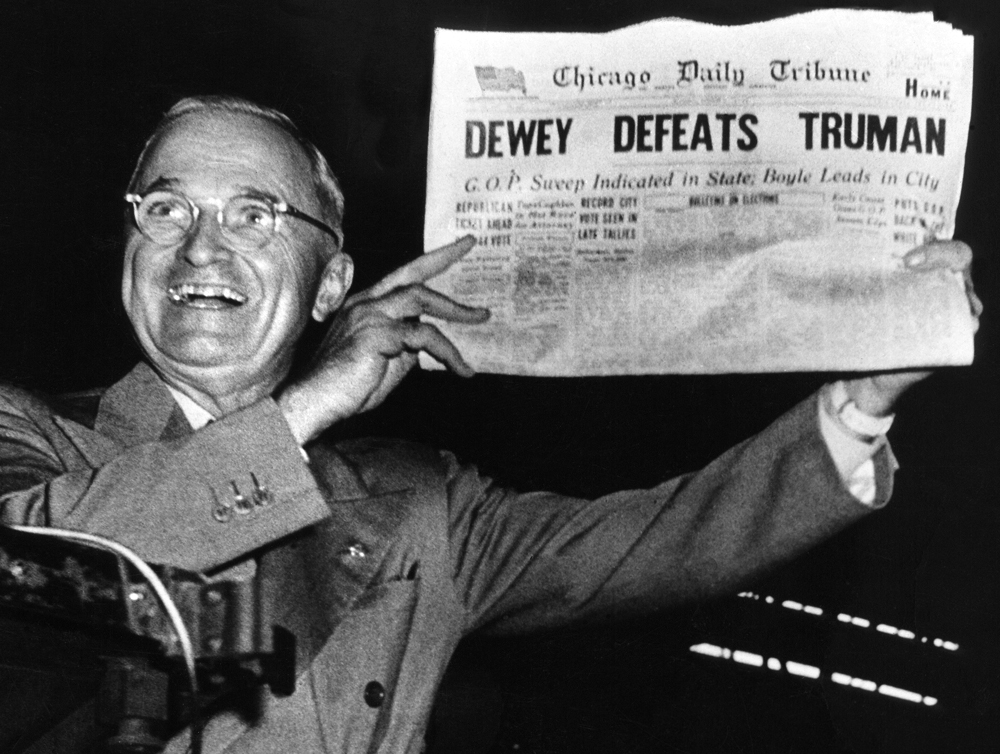Media Literacy: Don't Believe Everything You Read

Image via the American Library Association's "Libraries Transform" initiative, librariestransform.org
Just plain wrong, or actively lying?
"Dewey Defeats Truman." Photograph. November 4, 1948. United Press International.
When reading the news, you have to know the wider context. It is your job to check multiple unrelated sources and keep yourself informed.
News happens quickly (that's why they call it news — it's new information). Journalists can make projections in good faith, which then turn out to be incorrect. This is a common occurrence, but it is very different from actively misleading the public.
-
First Draft News: Understanding Information DisorderSome sources actively attempt to deceive and harm the public, leading to serious consequences for global health, international politics, and the economy. Rather than calling them "fake news," these sources could be more accurately described as misinformation, disinformation, or malinformation.
Standards of Journalism
-
Society of Professional Journalists: Code of EthicsThe four main points of the Code of Ethics: 1. Seek Truth and Report it; 2. Minimize Harm; 3. Act Independently; 4. Be Accountable and Transparent.
-
Center for Journalism Ethics, University of Wisconsin-MadisonResources provide an overview of journalism ethics, as well as links to specific news organizations' statements on ethics.
Same as it ever was
-
Columbia Journalism Review: The Real History of Fake NewsThis 2016 article from the Columbia Journalism Review provides historical context and examples of "fake news," from political mud-slinging to moon hoaxes.
-
JSTOR Daily: To Fix Fake News, Look To Yellow JournalismThis article from the JSTOR database's blog, JSTOR Daily, offers some background about the "yellow journalism" period of dishonest and sensationalized publishing.
Five Key Questions of Media Literacy
The Media Education Lab at the University of Rhode Island works to improve media literacy though scholarship, curriculum design, teacher education, and community outreach. These "Five Key Questions for Media Literacy" were developed by the Media Education Lab to provide a helpful framework for evaluating news and media sources. Whether you're reading an article shared on social media, watching a television news segment, or even looking at an advertisement, keep these five questions in mind and think critically about the sources you encounter.

Fact-Checking & Evaluating News
-
AllSidesAllSides displays top news stories from major media outlets on the Left, Center and Right of the political spectrum, giving you a side-by-side comparison of current news coverage.
-
FactCheck.orgA project of the Annenberg Public Policy Center of the University of Pennsylvania, FactCheck.org monitors the factual accuracy of speeches, debates, interviews, advertisements, and other statements from major U.S. political figures.
-
PolitiFactPolitiFact, owned by the nonprofit Poynter Institute for Media Studies, investigates and rates the accuracy of politicians' statements on a “Truth-o-Meter” scale.
-
SnopesFact-checking, investigative reporting, and evidence-based research into hoaxes, urban legends, and “fake news.”
Political Stances of Major News Sources
-
Should You Trust Media Bias Charts?Media bias charts, such as the one pictured below, can be a good starting point for understanding potential biases in specific news sources and publications. These charts will help you quickly determine if a source has a clear political bias or reputation for being unreliable. However, it's important to use your own critical thinking skills when reading news sources! You can consult a media bias chart to learn some context about an unfamiliar publication or website, but don't rely on a chart to evaluate your sources for you.

